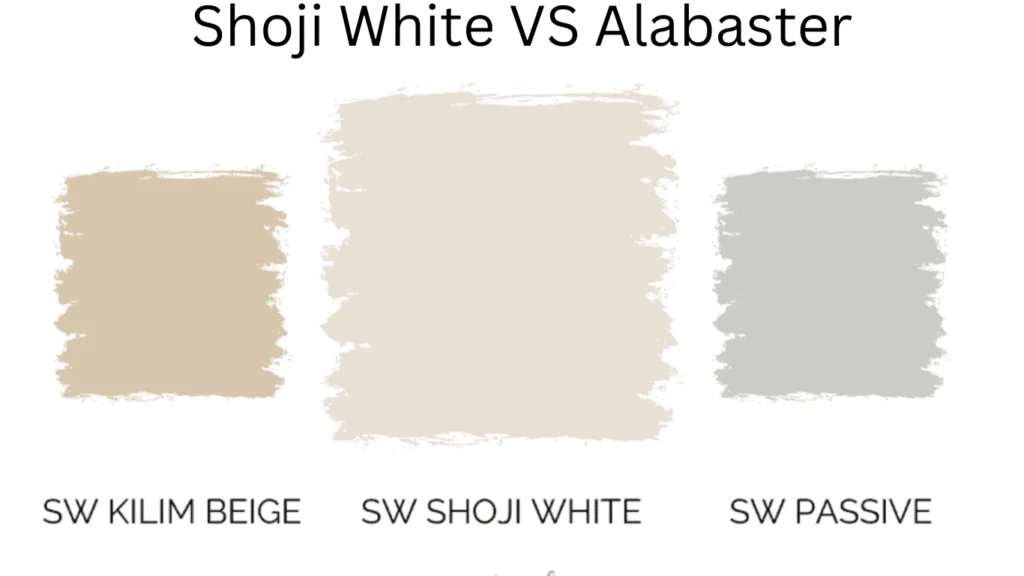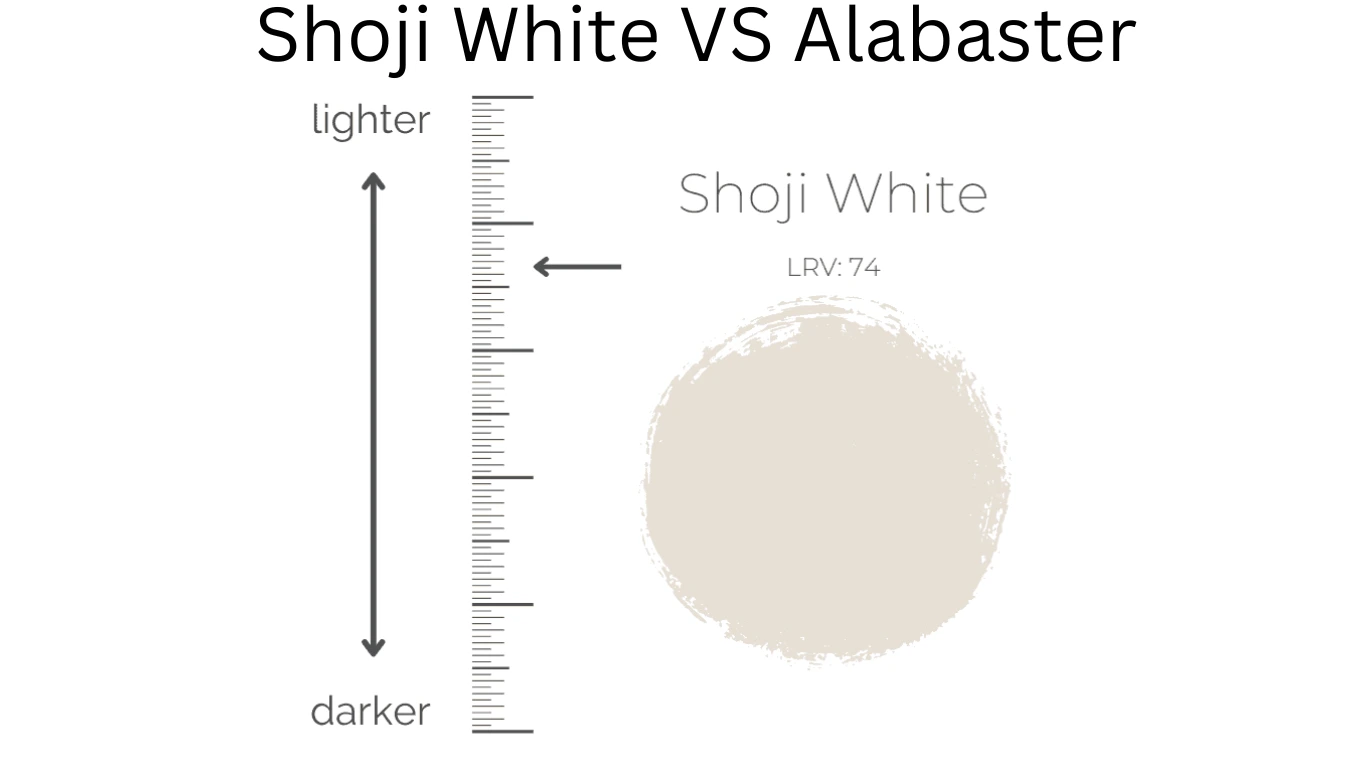Choosing the right shade of white for your home can be challenging. Two popular options from Sherwin-Williams, Shoji White and Alabaster, often come up in design discussions. They may seem similar at first glance, but these two shades offer distinct differences that can impact the overall look and feel of a space. In this article, we’ll provide an in-depth comparison of Shoji White vs Alabaster to help you decide which one is better suited for your interior and exterior design needs.
What is Shoji White?
Shoji White (SW 7042) is a warm off-white paint color that sits between white and beige. It has soft undertones of gray and beige, giving it a sophisticated yet cozy feel. This shade is known for its versatility, making it an excellent choice for various settings, from modern minimalist designs to more traditional interiors. It’s not as bright as true whites but still brings a refreshing lightness to a room.
What is Alabaster?
Alabaster (SW 7008), on the other hand, is a creamy, soft white with a hint of warmth. With its subtle yellow undertone, Alabaster adds a timeless charm to spaces. It’s more popular than Shoji White because it works well across a variety of design styles, from farmhouse chic to classic and coastal. While Alabaster is considered a warm white, it is still soft enough not to overpower a room.
Light Reflectance Value (LRV): Shoji White vs Alabaster
A crucial factor in choosing between Shoji White vs Alabaster is their Light Reflectance Value (LRV), which measures how much light a paint color reflects. Shoji White has an LRV of 74, making it less reflective and slightly darker than Alabaster. It’s a good option for rooms that receive ample natural light, as it won’t make the room feel too bright.
Alabaster, with an LRV of 82, is a brighter shade that works well in both well-lit and dimly lit spaces. Its higher LRV makes it a great choice for north- and east-facing rooms, as it adds warmth to cooler lighting. This makes Alabaster a good candidate for brightening up darker areas without feeling too stark.
Undertones Shoji White vs Alabaster
The undertones of these two paint colors create the most noticeable difference. Shoji White has warm undertones with hints of beige and gray, which prevent it from appearing overly yellow. It adapts to its surroundings, which makes it a flexible option for rooms with different lighting conditions. It’s one of the few creamy off-whites that works well even on kitchen cabinets.
In contrast, Alabaster has warm, creamy undertones with a touch of yellow. While this gives it a soft, welcoming vibe, it can appear more yellow next to brighter whites. However, in most lighting conditions, Alabaster retains its creaminess without looking overly yellow.
Where to Use Shoji White in Your Home?
Shoji White is a versatile choice for nearly any part of your home. Its soft beige undertones make it suitable for walls, trim, cabinetry, and even exteriors. It works exceptionally well in rooms with lots of natural light, where its slightly darker tone won’t make the space feel too washed out. It can also be used for interior walls, providing a warm, neutral backdrop that pairs well with both light and dark accent colors. Shoji White is also a great option for exteriors, as it adds a subtle warmth that complements natural elements like wood and stone.
Also, Read Trituetheky21.com: Your All-in-One Online Platform

Where to Use Alabaster in Your Home?
Alabaster is a classic choice that works well in many areas of the home, particularly in spaces that need a warm, cozy ambiance. It’s ideal for north- and east-facing rooms, as its creamy undertones balance the cooler natural light found in these areas. Alabaster also works well for exterior walls, adding a soft brightness that doesn’t look too harsh. However, Alabaster may not be the best choice for kitchens and bathrooms with bright white countertops or backsplashes, as it can highlight the yellow undertones.
Coordinating Colors: Shoji White vs Alabaster
While choosing between Shoji White vs Alabaster, consider their coordinating colors to achieve the desired look for your home.
Shoji White pairs well with warmer, subdued colors like taupes, soft greens, and warm grays. It also works nicely with dark accent colors like Urbane Bronze for added contrast.
Alabaster, with its creaminess, coordinates beautifully with other warm neutrals like beige, light taupe, and soft browns. For trim, Pure White is a great match, as it brings balance to Alabaster’s yellow undertone without clashing.
Can You Use Shoji White and Alabaster Together?
When comparing Shoji White vs Alabaster, one question often arises: Can these two colors be used together? While it’s possible to mix and match various shades of white, pairing Shoji White and Alabaster can be tricky. Alabaster’s creaminess may appear too warm against the more neutral Shoji White. To create a more cohesive look, consider using Pure White as a transition shade if you want to incorporate both Shoji White and Alabaster in a home.
Which is Better Shoji White vs Alabaster?
The answer largely depends on your design goals and the specific areas where you plan to use these colors. If you’re looking for a more flexible option that can be used throughout your home, Shoji White may be the better choice. Its neutral undertones allow it to work well in various spaces and lighting conditions, making it suitable for a whole-house color scheme.
Alabaster, meanwhile, offers a classic, creamy finish that works well for exteriors, north-facing rooms, and cozy interiors. Its yellow undertones make it a great choice if you’re aiming for a warmer, softer aesthetic.
| Feature | Shoji White | Alabaster |
| LRV | 74 | 82 |
| Undertones | Beige, Gray | Yellow |
| Brightness | Moderate | Brighter |
| Best for | Interiors, Cabinets | Exteriors, Cool Rooms |
| Avoid for | Dimly lit rooms | Kitchens with bright white countertops |
Frequently Asked Questions
Is Shoji White warmer than Alabaster?
No, Alabaster is warmer due to its yellow undertones, while Shoji White has more beige and gray undertones.
Can Shoji White be used on cabinets?
Yes, Shoji White works well on kitchen and bathroom cabinets, providing a soft, neutral look.
Does Alabaster look yellow?
Alabaster has a creamy yellow undertone, but it generally appears soft and warm rather than overly yellow.
Is Alabaster good for trim?
Alabaster can be used for trim, but it may be too warm if paired with bright white walls. Pure White is a better choice for trim when using Alabaster.
Conclusion
When deciding between Shoji White vs Alabaster, consider your lighting conditions, design style, and personal preferences. Shoji White offers versatility and works well in a variety of settings, while Alabaster provides a classic, warm touch that’s perfect for exteriors and cooler rooms. Both colors have their strengths, but Shoji White may be the better all-around choice due to its neutral undertones and flexibility. Use this information to make the right choice for your home
Also, Read PedroVazPaulo Business Consultant: Redefining Success

